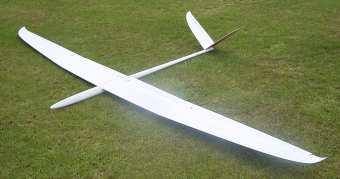

by Graham Woods in May 2000
I reckon this, the newest F3X model from the Fischer workshop, must take a prize for innovation. The new idea I'm talking about is in the wing construction. I not sure exactly how these models are made but each wing uses some 33 metres of carbon fibre braiding (or sock if you like) (gewebeschläuche) in the wing and does not seem to have a conventional spar. The finished hollow-shell wing ends up with multiple shear webs that remind me of the structure of fragile, yet strong, bird's wing bones. My brother David brought his new model round for me to see after his year-long wait for delivery; I took a few digital snaps...
How is the wing made? I don't know but... |
Estrella Vital Statistics |
||||||||||||
| I believe the wing is made in a regular mould with the carbon skins laid up in the normal way; however, the difference between this and a 'conventionally' sparred wing is the use of carbon fibre braiding. Michael Imsic from Australia tells me: "The wings are constructed open ended and the carbon socks are placed over silicon profiles which have a bladder over them. The silicon is inserted into the wing and the bladders are blown up. Once the epoxy has cured the silicon and bladders are removed through the end of the wing. |
|
![]()
![]()
The Estrella fuselage at 32-40mm wide is definitely narrow. AA size cells are the order of the day and 5 Sanyo 1100's squeezed in, sub-C size cells simply will not fit. You'll probably need a new compact receiver as well since the internal space is limited. This particular fuselage was not the greatest quality I've seen - there were 'bubbles' in the gel coat - a fault in the moulding process - I know I've made the same mistake myself. Having said that, the fuselage seems to be made in a complex way from 5 mouldings (plus 2 for the flimsy nosecone) using carbon, glass and Kevlar in its build. It comes out very light but it was very strong. I think parts of it may be of sandwich construction. The nosecone is very thin, apparently designed for the servo horns to rub its insides for some reason.
Carbon tows along inside the fuselage threaten radio reception, as usual, so David has his aerial taped to the outside. Ballast is available for the model: it is not lead but brass in the shape of rectangular blocks, there are square aluminium tube spacers too to provide some variation in carry weight. Total ballast is just over 1kg. Casting some lead of your own to fit would increase this weight by around 30%.
As I explained the wing is novel. It seems we've all got to wait until a broken one turns up to see exactly what's inside. (Can't wait J The wing is better made than the fuselage and bottom hinged with the aileron and inboard flap pushrods exiting the top surface through the small shrouds to the control horns. The aileron is very long with the flap quite short - you'll have to click on the 3-view thumbnail below to see what I mean. Look carefully for six shear webs the brading makes and the unusual wide, tapered spar caps (~40mm) on the top and bottom of the wing showing here as a thickened black wing skin. The construction is described as CFK Hohlschale (Lit. Carbon reinforced plastic hollow shell). I think there is some sandwich construction in the wing as well (0.5mm balsa) - GFK-AFK Sandwich (Lit. Glass and aramid reinforced plastic sandwich) is the wording used. Sandwich construction is used to prevent surface denting which would occur with just a thin carbon skin but I couldn't really see the innards. This wing is magnificent in torsion by the way. The one thing that appeals to me with this model is the ease and speed of assembly: a 2-piece wing, 2 easy plugs, one huge square dowel, one screw and 2 ball joints. The model comes out very light at 2.2kg for a 3.2m model. A little too light perhaps?
Well, brother David tells me (from his first few flights) that this model does not soar as well as he expected. With a 3+ metre span, 2.3% camber and flapperons one might think that its soarability would be very good but the Martin Weberschock profile MW3 seems to be an unknown quantity. The launch window in F3F is a good test of soarability and David said, in his opinion, the Estrella comes a poor second to its sister model, the V-Ultra Picco in the pre-race 30 second dash to gain height. ( Or maybe it was just the lift on the day?) Those complex tips make it susceptible to tip stalling as well. David tells me he got caught out with the model flicking unexpectedly on 3 occasions. I hear tell it does this on the winch line too. I'm also told that the width of the flaps and ailerons was increased this year (from the original wing) to give better handling and tow. Setting up and trimming is said to need quite a bit of expertise to get the most out of the model and its wing section. (This may be the reason my brother David said it failed its soarability test in his initial flights.)
With its first flights on the day of an F3F competition David placed a respectable 5th with an untried/untrimmed model. He says. it is very fast, perhaps faster than his Picco, and very surprisingly stable... point it, and it goes dead straight lie in that direction unwaveringly. It's probably excellent for distance in F3B. More flights and perhaps we'll know more...
![]()
Visit the Fischer Workshop. Look at the V-Ultra Picco.
![]()